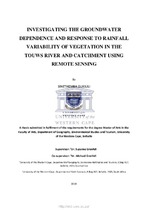Investigating the groundwater dependence and response to rainfall variability of vegetation in the Touws river and catchment using remote sensing
Abstract
Changes in climate patterns have raised concerns for environmentalists globally and across southern Africa. The changes greatly affect the growth dynamics of vegetation to such an extent that climate elements such as rainfall have become the most important determinant of vegetation growth. In arid and semi-arid environments, vegetation relies on near-surface groundwater as the main source of water. Changes in the environment due to climate can be examined by using remotely sensed data. This approach offers an affordable and easy means of monitoring the impact of climate variability on vegetation growth. This study examined the response of vegetation to rainfall and temperature, and assessed the dependence thereof on groundwater in a climatically variable region of the semi-arid Karoo.
The methodology used included sampling plant species in the riparian and non-riparian areas over two plant communities in seven vegetation plots. The Normalised Difference Vegetation Index (NDVI) derived from the Landsat OLI and TM was used to measure vegetation productivity. This was compared with rainfall totals derived from the Climate Hazards Group InfraRed Precipitation with Station data (CHIRPS) and the mean monthly temperature totals. A drought index, (Standardised Precipitation Index – SPI) was an additional analysis to investigate rainfall variability. Object-based Image Analysis (OBIA) and Maximum Likelihood supervised classification approaches together with indicators of groundwater discharge areas (Topographic Wetness Index – TWI, and profile curvature) were used to map vegetation and surface water that depend on groundwater.

